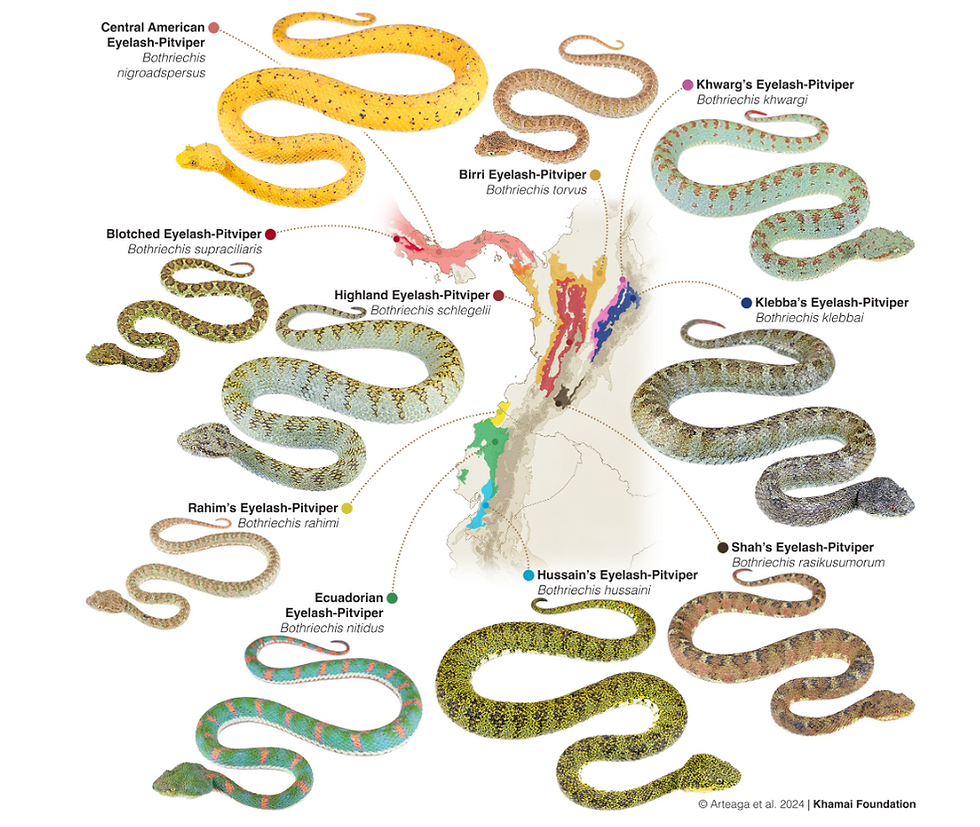The Hidden Truth Behind the Eyelash Viper
- César L. Barrio-Amorós CRWild

- Feb 9, 2024
- 4 min read
Updated: Feb 11, 2024
NEOTROPICAL EYELASH VIPERS
In 2014, sitting with Alejandro Arteaga, Abel Batista and Claudia Koch, on a terrace in Cartagena de Indias, enjoying a cold beer after a busy day at the X Latin American Congress of Herpetology, an idea emerged that at the time seemed basically impossible, reviewing the Bothriechis schlegelii complex. Both Alejandro and Lucas Bustamante, who were in Costa Rica for the I Costa Rican International Symposium of Herpetology, and later traveled parts of the country with César Barrio-Amorós, as well as César himself when he was in Ecuador observing the first "oropeles" obtained in the country along with Alejandro and Lucas and then the famous green "schlegelii" of the Chocó, and as Abel with his own perspective of Panamanian specimens he knew perfectly, all agreed that that name schlegelii was too pretentious, and that it surely must hide a series of cryptic species (or not so much).

During César's visit to the Alexander Koenig Museum in Bonn, Germany, along with Claudia Koch, they examined the newly rediscovered holotype of B. schlegelii (which had been thought lost since after World War II due to the Allied bombings of many German cities), realizing it was a juvenile and that it needed to be redescribed, applying that name only to the species from Popayán in Colombia. Soon after, Claudia, together with her colleague from the Natural History Museum in Vienna, Alice Schumacher, found the holotype of Bothrops (Teleuraspis) nigroadspersus by Steindachner, recognizing that this should be the name assigned to the Central American species, although its type locality was very general and did not give clues as to where it was collected (Central-America).
Bothriechis nigroadspersus from various locations in Costa Rica and Guatemala. Photos: César Barrio-Amorós.
Bit by bit, the puzzle was pieced together, and while Alejandro continued to collect data in the field and orchestrate the overall work, Eric Smith and other colleagues prepared the hemipenis of each species under their care, José Vieira produced his already classic spectacular images on a white background for publications, Elson Meneses supported from Colombia, César spent his time counting tiny scales under the microscope at the UCR, and Alexander Pyron utilized his skills to run the molecular data...
Like a well-coordinated team, the final result came in the form of one of the most anticipated taxonomic articles of the year: Systematic revision of the Eyelash Palm-Pitviper Bothriechis schlegelii (Serpentes, Viperidae), with the description of five new species and revalidation of three.
What's up, doc?
Bothriechis schlegelii was described by A.A. Berthold in 1846 from a juvenile specimen from Popayan, Colombia. Gunther, in 1859, named Lachesis nitidus from the western Andes of Ecuador. In 1870, Steindachner described Bothrops (Teleuraspis) nigroadspersus from Central America. And Posada Arango in 1889 named Tanatophis torvus from the "warm places of Antioquia." All these names were placed under the synonymy of Bothrops schlegelii, and later were assigned under the genus Bothriechis by Peters (1859).
Until now, all neotropical eyelash vipers, except B. supraciliaris, which Edward Taylor described as a subspecies in 1954 from the mountains near San Isidro del General in Costa Rica, had been attributed to the species B. schlegelii, dedicated to the German zoologist Hermann Schlegel. And although many authors, including the great Jay Savage, thought that the great complexity of coloration patterns made it difficult and could hide a correct classification of the complex, few dared to do anything about it.
Until this project began to take shape.

Proposed Changes
A refined review of morphological data (meristics, hemipenes) plus a molecular phylogeny endorsed by knowledge of the biogeography of Northwestern South America and Central America, offered the following results.
Bothriechis schlegelii remains as an endemic species of the Central Andes of Colombia, and therefore, no other population can receive that name.
Bothriechis schlegelii from Popayán (type locality), Antioquia, and Quindío, Colombia photos: Cesar Barrio Amorós.
Three names are reclaimed for monophyletic populations. B. nigroadspersus for the Central and Mesoamerican population, from southern Mexico to eastern Panama. B. torvus for the northern Chocoan population, from eastern Panama through the northern Chocó and also through the lowland areas of Antioquia. And B. nitidus for the population on the western slope in Ecuador.
Bothriechis nitidus, Chocó ecuatoriano. Fotos: César Barrio-Amorós..
Bothriechis supraciliaris remains unchanged.
Bothriechis supraciliaris from Costa Rica. Photos: César Barrio-Amorós
Five new species are described:
Bothriechis rasikusumorum from the department of Huila but extending into the Andean Amazon slope, would be the only species of the complex present in the Amazon. Endemic to Colombia.
B. khwargi is distributed along the western slope of the Eastern Cordillera of Colombia, being endemic to this country.
Bothriechis khwargi from Santander, Colombia. Photos: César Barrio-Amorós
B. klebbai, also from the western slope of the Eastern Cordillera of Colombia, but distinguished from the previous one by morphological and molecular characteristics; also endemic to Colombia.
B. rahimi. I remember the first time I was in Ecuador, in 2014, with the Tropical Herping team we observed two oropeles (golden vipers of the schlegelii complex), which for me was something normal living in Costa Rica. But for them, it was a notable discovery, since oropeles were not known in Ecuador. Well, these now belong to this species, B. rahimi, from the extreme northwest of this country and extreme southwest of Colombia.
Bothriechis rahimi from the Ecuadorian Chocó. Photos: César Barrio-Amorós
B. hussaini, from the southwestern slope of Ecuador and the extreme northwest of Peru.

Bothriechis hussaini from the southwest of Ecuador. Photo: Gerardo Ramos.
Article Link:
Arteaga, A. R.A. Pyron, A. Batista, J. Vieira, E. Meneses Pelayo, E.N. Smith, C.L. Barrio Amorós, C. Koch, S. Agne, J.H. Valencia, L. Bustamante, K.J. Harris. 2024. Systematic revision of the Eyelash Palm-Pitviper Bothriechis schlegelii (Serpentes, Viperidae), with the description of five new species and revalidation of three. Evolutionary Systematics. 8 2024, 15–64 | DOI 10.3897/evolsyst.8.114527






























































Comments